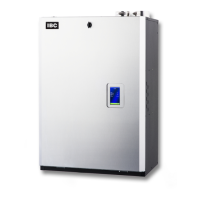Fluid fill is most often accomplished by using a boiler regulator and fill valve set at 12 psig or
more, with the appropriate backflow prevention device as required by local code. This is
acceptable in areas where municipal water or well water has been treated and filtered to
remove excessive minerals and sediment, and water chemistry is known to be suitable for
closed loop hydronic systems. In areas where water quality is in question, or when chemical
treatment or glycol is required, other options should be considered. Follow the applicable
codes and good piping practice.
Warning
Close the fill valve after any addition of water to the system, to reduce risk of water
escaping.
Today, there are a number of boiler feed and pressurization devices on the market that may
be a better choice than a raw water fill from the mains. When regular maintenance requires
relief valve blow-off, the discharge may be directed back into the pressurization appliance for
recycling of boiler fluid and chemicals back into the system. In buildings that may be
unoccupied for long periods of time, pressurization appliances are useful to prevent flood
damage should leakage occur from any component in the system. An additional benefit is
that backflow prevention devices are not required when using these devices.
Do not place any water connections above the boiler to avoid damage to the fan and controls.
If needed, create a shield over the top of the cover, but allow clearance for airflow and service
access.
Primary-Secondary piping
For best results, use a primary/secondary piping system, with a pumped boiler loop using 2"
piping. Primary/Secondary piping ensures adequate flow and de-couples Δ°T issues (boiler
vs. distribution). Aim for a 20 °F to 30 °F Δ°T across the heat exchanger at high fire (there is a
boiler protection throttle fence limiting the Δ °T to 40 °F).
For the SL 40-399 G3 model, the minimum flow rate required through the heat exchanger is
20 gpm and a maximum of 45 gpm. To ensure adequate water flow through the boiler under
high-head / single zone space heating conditions, you must use a pressure activated bypass
or other means of bypass on any load where the flow rate might drop below minimum
requirements (20 gpm). Check valves or thermal traps should be used to isolate both the
supply and return piping for each load - to avoid thermal siphoning and reverse flow.

